Keywords
Trawl escapement, bosom and upper bag, codend, cover, bottom trawl
Introduction
Otter trawls are used extensively as sampling tools to improve estimates of population sizes and to obtain other biological data required for management of various ground fish stocks (Walsh, 1992). The capture efficiency of a trawl or its selectivity depends on the type of trawl, how and when it is used, the behaviour of the individual fish in the population, and the interaction of these intrinsic and extrinsic factors in the fish capture process (Pope et al., 1975). This concern has been a matter of interest for a many years (Dahm, 2000). With the use of underwater camera, TV, and acoustical device technology scientists could detect trawl efficiency and fish behaviour (Lange and Steinberg, 1989). Fish form schools, layers, or patches in which an individual fish’s behaviour is not independent of its neighbours’ movements. However, at low densities fish may have the space to act as independent individuals. Potentially, this may give rise to differences in behavioural reactions of fish in front of the trawl at high and low densities. Such reactions could increase escapement from the trawling zone or the increase capture success, both having successive effects on the estimates of catchability and indices of stock abundance (Godo et al., 1999). Therefore, fish behaviour and catch efficiency as escapement of fish have been extensively studied including escapement from underneath of ground rope (Enrich, 1987; Dahm and Wienbeck, 1992; Walsh 1992) and escapement from different parts of trawls (Nakashima 1990; Dremier et al., 1999). Studies revealed that escapement of fish occur from not only the codend but also from other parts of a trawl net such as footrope, headline and body. However, there is no information about escapers from bottom trawls that are commonly used. Therefore, we aimed to determine the species composition and ratios of escapements from codend, underneath of footrope and above headline model in bottom trawl net.
Materials and Methods
The study was carried out between August 2006 and February 2007 during all daylight hours, using research vessel “EGESUF” 26.8 m LOA, and 500 hp main engines. A bottom trawl, 600 meshes around the footrope level was used (Figure. 1). There were no cutting/ tailoring techniques for construction of the nets. They are performed from rectangular net pieces which are laced together as a conical shape (Tosuno?lu et al., 1996). In order to provide horizontal mouth opening, models were used in upper and lower part. Model nets were made with hand as a triangle shape. These nets were the widest mesh sizes in the trawl with 110 mm.
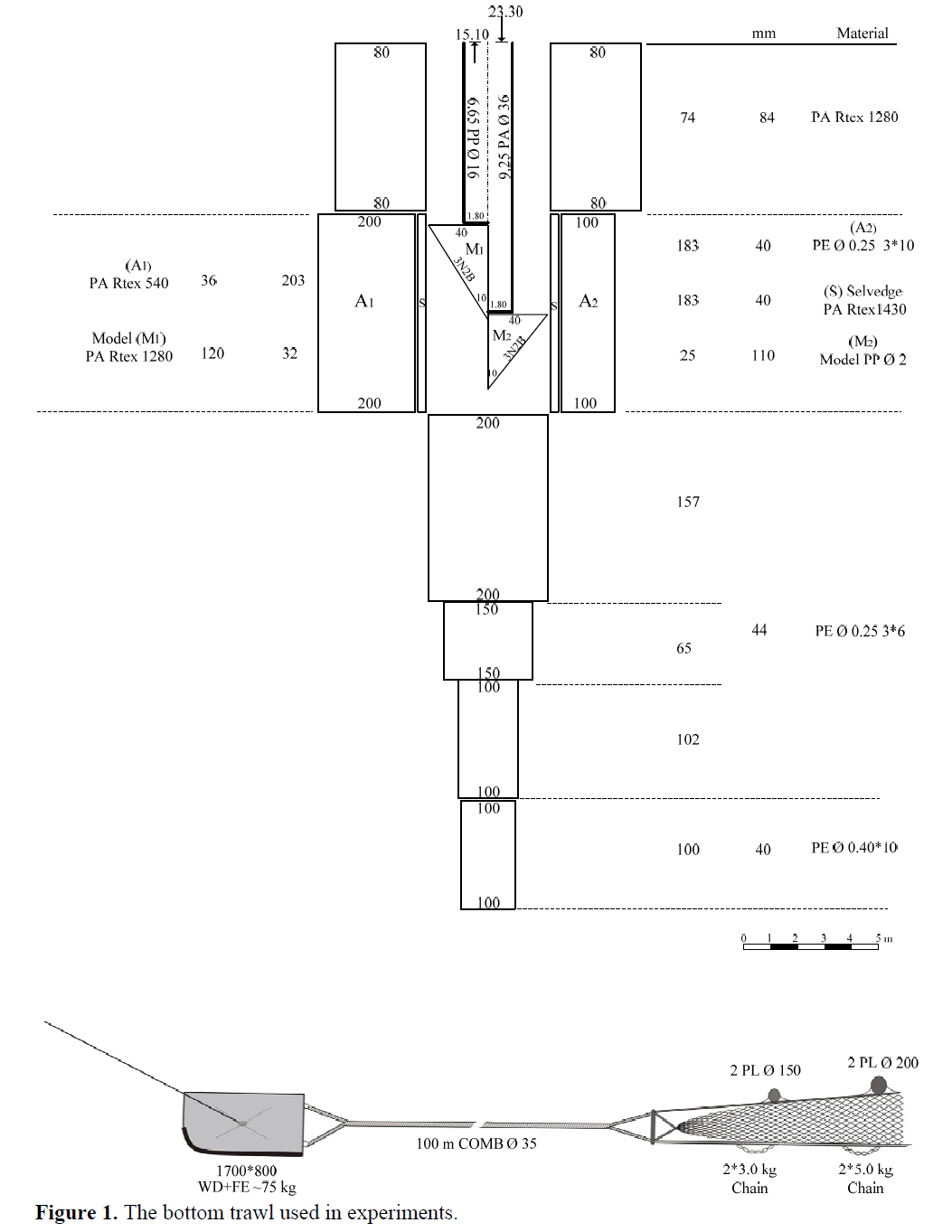
Figure 1. The bottom trawl used in experiments.
The experimental bag nets were constructed in order to obtain escaping fish from underneath of footrope and above headline model. Technical drawings of bosom bag (bb) and upper bag (ub) were given in Figure 2. Bosom bag was attached under the bottom model and rigged throughout the selvedge. Approximately 1 kg chain was employed in order to ensure gap between fishing line and bosom bag. Upper bag laced to the outside of headline above the upper model. Four floats each was Ø 15 cm plastic were used for the purpose of avoiding masking effect. They covered 100 % of the models. Codend cover (cc) was fitted over the codend. Cover as described in detail by Tosuno?lu et al. (1997). These bags were made from knotless polyamide (PA) material, Rtext 620 and 24 mm mesh sizes. In addition, a nominal 40 mm polyethylene codend represented the landed catch was used.
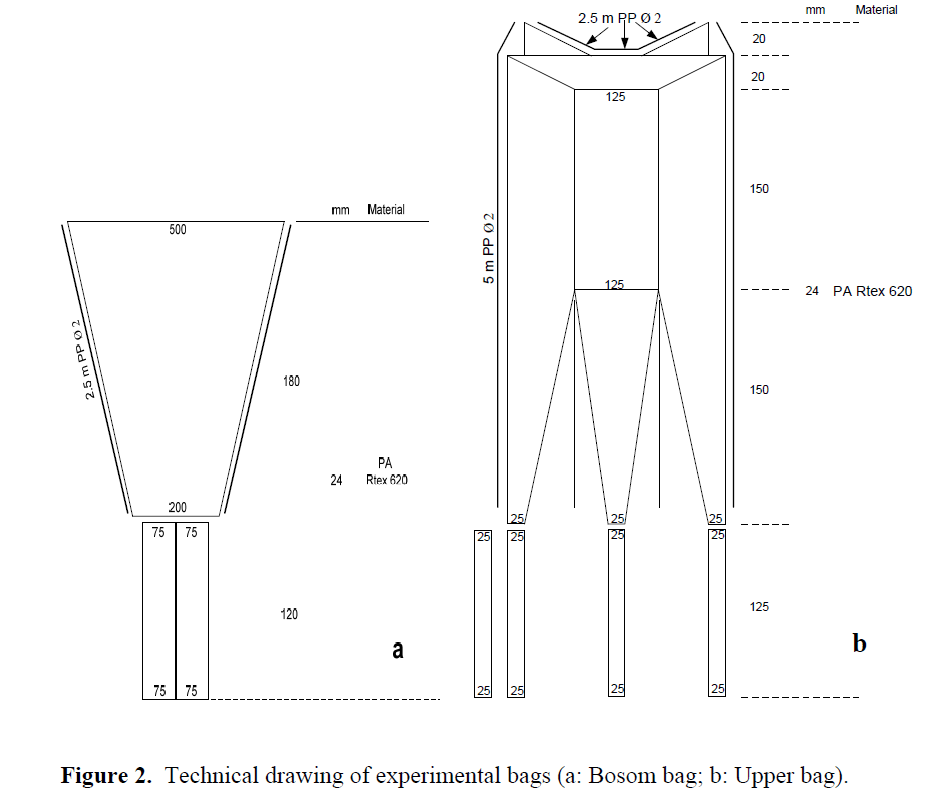
Figure 2. Technical drawing of experimental bags (a: Bosom bag; b: Upper bag).
A total of 12 fishing sets were completed. The duration of each set was a standard 30 minutes tow with an average vessel speed of 2.4 knot (ranged between 2.0-2.7 knot) on sandy and muddy bottom. Only 9 set caused no damage to either bags or main codend, and these were used in the analyses. The trawl catch were sorted into species and counted. Length measurement (to the nearest centimetre) was made in total length for abundant species; annular sea bream (Diplodus annularis), red mullet (Mullus barbatus) and scald fish (Arnoglosus laterna). Yet, caught debris (dead or live shell) in bosom bag and codend were not included in the analyses.
Non-parametric and parametric statistical tests were applied to analyze using numbers of individual species. Kruskal-Wallis one way analyses of variance (K-W) conducted to determine differences of individual species and numbers between the hauls. This test was also applied to differences between experimental bags for annular sea bream and scald fish specimens. K-W test was not available for red mullet because there were no specimens in upper and bosom bag. Hence, it could be compared with Wilcoxon matched paired test so as to determined differences between codend and cover specimens. This test was also applied to the significance between the numbers of specimens in codend – cover, codend - bosom bag, cover - bosom bag, cover - upper bag and codend - upper bag.
Kolmogorov-Smirnov (K-S) test was used to determine the differences between length distributions of experimental bags.
Jaccard similarity coefficients, which make use of only presence/absence data, were calculated in order to determine similarities of species between experimental bags. All statistical routines except Jaccard were carried out with Statgraphics, version 6. Jaccard similarity values were calculated with BioDiversity Professional Version 2.
Results and Discussion
A total number of 24 932 specimens belonging to 34 species were caught from 9 valid hauls. Table 1 shows species composition and their percentages in total catch and experimental bags. Annular sea bream was the dominant species, representing 30 % of the total catch, followed by red mullet, (27.1 %), scald fish (14.5 %), thickback sole (Microchirus variegates) (9.5 %) and brown comber (Serranus hepatus) (8.9 %), respectively. Remaining 10 % of total catch was composed by other 29 species.
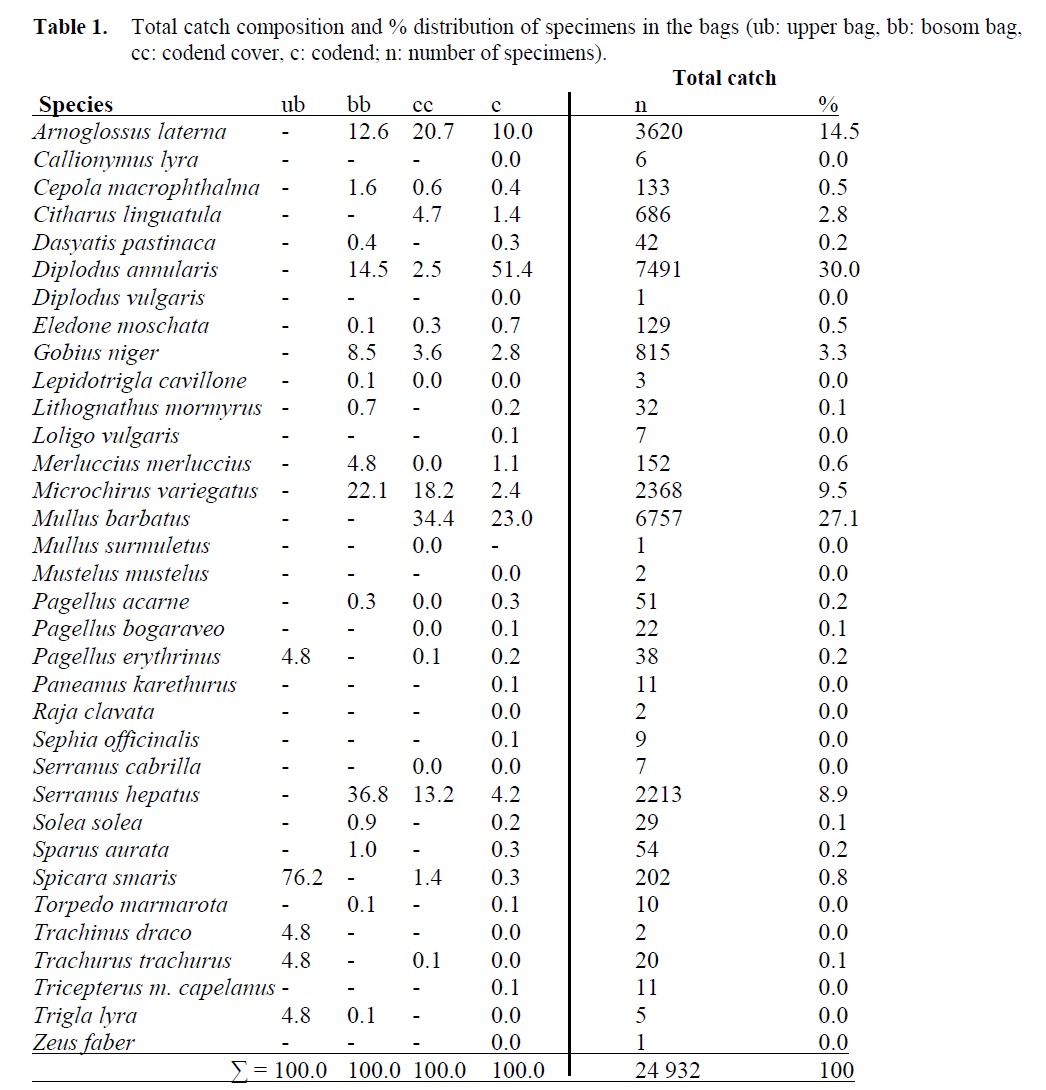
Table 1. Total catch composition and % distribution of specimens in the bags (ub: upper bag, bb: bosom bag, cc: codend cover, c: codend; n: number of specimens).
Upper bag had the lowest catch values with 0.1% including 6 species. Spicara flexuosa was the dominant species representing %76.2 in this bag. 2.8% was caught in bosom bag indicating that the escapes from underneath the footrope composed of 16 species: Brown comber, thickback sole and annular sea bream were the dominant species with 36.8, 22.1, and 14.5 %, respectively. In addition, 53 kg of echinoderms, bivalves, and gastropods were caught in this bag, but this was not included the calculations. 41.6 % of the total catch, including 18 species, were caught in the cover. Red mullet was the dominant species with 34.4 % followed by scald fish and thickback sole with 20.7 % and 18.2 %, respectively. 55.6 % of total catch was caught in codend, and represented landed catch, including 33 species. The dominant species were determined as annular sea bream, red mullet and scald fish with catch values of 51.4, 23 and 10%, respectively.
K-W test indicated that there were no differences between the species number and number of specimens between the hauls (K-W=0.008, p>0.05).
Jaccard similarity coefficients were given in Table 2, and Wilcoxon matched pairs test results between bags were shown in Table 3. In accord with, the highest Jaccard similarity coefficient for species number was found between codend and cover with a 0.50. However, there were no differences in number of specimens (z=0.652, p>0.05) Furthermore, codend - bosom bag similarities was found as 0.48 and differences between the numbers of specimens was significant (z=0.0003, p<0.05).
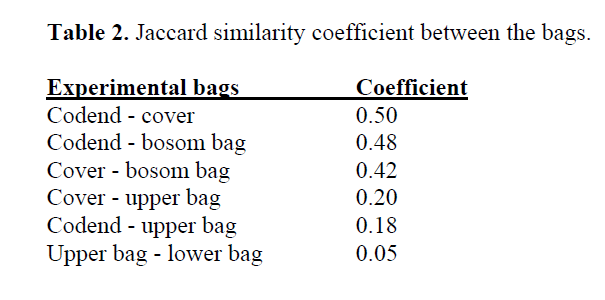
Table 2. Jaccard similarity coefficient between the bags.

Table 3. Results of the Wilcoxon matched pairs test applied to number of specimen difference between bags.
Besides, cover–bosom bag similarities was determined as 0.42 and the number of specimens difference between these bags was significant differences (z=0.0006, p<0.05). Cover and upper bag a similarity was calculated as 0.20. Specimens’ differences of these bags were not significant (z=0.06, p>0.05). On the other hand, there was only one common species, piper gurnard (Trigla lyra), in the upper and bosom bag catches. Therefore, similarity value was determined as only 0.05. Owing to not enough specimens, Wilcoxon matched pairs test could not be performed between these bags.
During the experiments, a total of 7 491 annular sea bream were caught. The length of the species ranged from 8 to 18 cm (Figure. 3a). The length frequency distributions of codend, cover and bosom bag were determined with major peaks at 12 cm for codend, at 11 cm for bosom bag and at 9 cm for cover. Because there were no specimens in upper bag, it was not added to this figure. K-W analysis of variance demonstrated that there were significant differences between bosom bag, cover and codend specimen (K-W=0.00003, p<0.05). In addition, K-S test indicated that there were significant differences of length distribution between bosom bag and codend (D(max)=0.02721, D(α)=0.00016, p<0.05) and codend and cover bag (D(max)=0.70974, D(α)=0.00006, p<0.05).
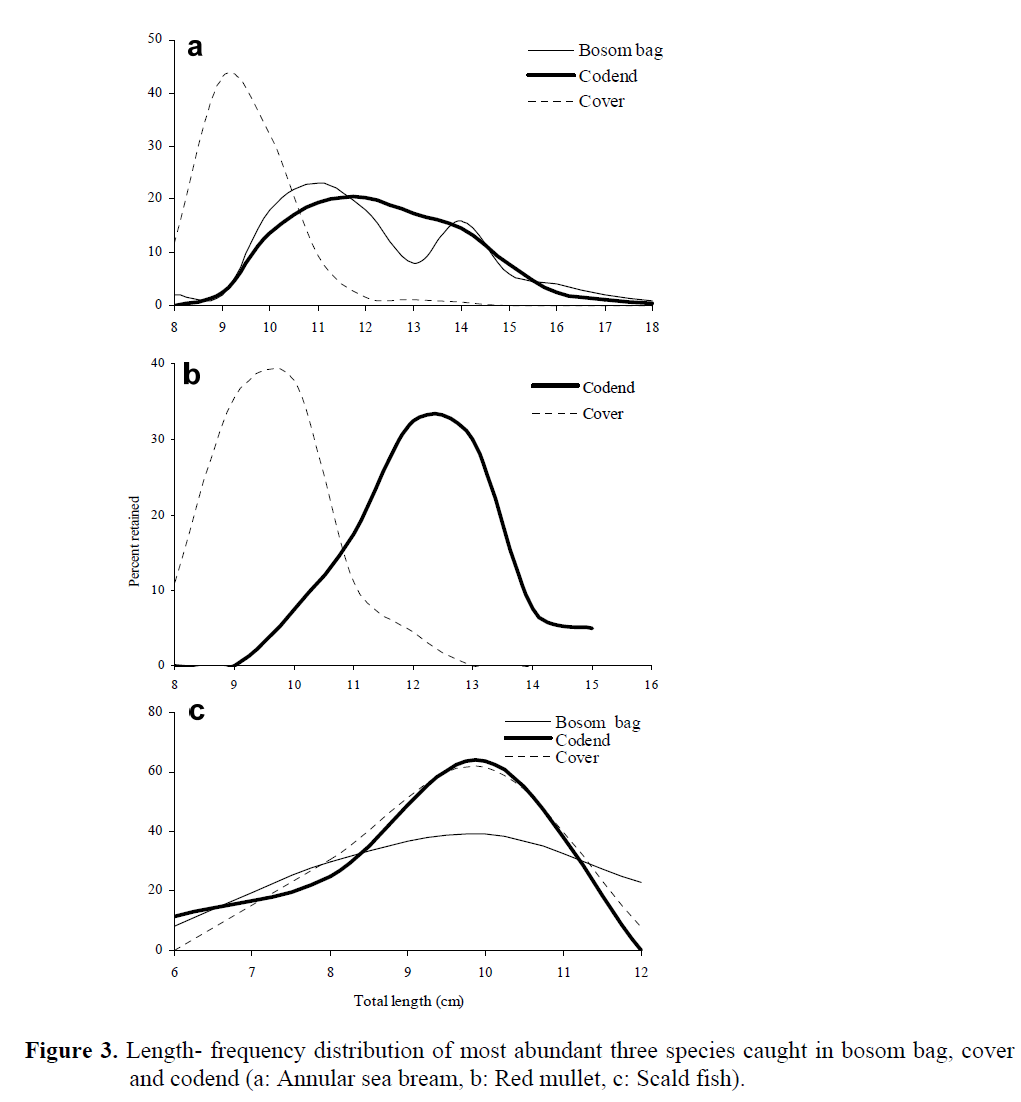
Figure 3. Length- frequency distribution of most abundant three species caught in bosom bag, cover and codend (a: Annular sea bream, b: Red mullet, c: Scald fish).
A total of 6 737 specimens of red mullet were caught. The total length of the species ranged from 8 to 15 cm (Figure. 3b). The length frequency distributions of codend and cover were determined with major peaks at 12 cm and 10 cm, respectively. There were no specimens in upper and bosom bag. Therefore, Wilcoxon matched pairs test was utilized. This test showed that there were no significant differences between cover and codend specimen (z =0.478, p>0.05). Nevertheless, K-S test indicated that there were significant differences between length distribution of codend and cover (D(max)=0.76941, D(α)=0.00001, p<0.05).
A total of 3 601 specimen of scald fish was caught. Their length range changed from 6 to 12 cm (Figure. 3c). The major peaks of codend, cover and bosom bag were found same as 10 cm. Besides K-W test showed that there were significant differences between bosom bag, cover and codend (K-W=0.00077, p<0.05). Besides, significant difference between codend and cover length distribution for this species was found by K-S test (D(max)=0.363636, D(α)=0.00003, p<0.05).
Our results indicated that annular sea bream was the most abundant species during the experimental period with 51.4 % in the codend. However, Metin et al. (2000) determined that annular sea bream was the most dominant species through the year except autumn season; the differences between the studies may be due to the details of the fishing grounds, water depth and experimental period.
The composition of escapees from various parts of trawl nets has been studied by others. There are some studies about escaped fish from various parts of trawl (Nakashima, 1990; Munro et al., 1997; Dremier et al., 1999; Polet 2000). However, due to the differences in the gear constructions, mesh sizes, netting materials, and populations fished, the results of these studies are not directly comparable to those found in the present experiment.
Bag net methods have been used on a number of studies in order to retain the fish that escape from different part of trawls (Walsh, 1989; Godo and Walsh, 1992; Dahm 2000). Studies demonstrated that attaching bag nets does not change the net geometry. However, it was reported that long tows could be problematic due to accumulation of debris (Dahm and Wienbeck, 1992). During our 30 minutes experiments that was carried out in sand or muddy ground no bag damage was reported.
Escapement is known to increase as the height of footrope above the bottom increases (Korotkov, 1984). In other words, better bottom contact reduced the escapement of ground gear (Engas and Godo, 1989). In general, chain or lead is directly attached to the ground rope. Consequently, low value of retained fish with 2.8 % from bosom bag may be due to direct contact of ground gear.
Since the widest meshes are in lower part of the trawl net, in the present study only the bosoms were covered. Ingolfson and Jorgensen (2006) reported that most escape occurred from bosom compared to starboard and port bags. In addition to fish 53 kg debris (dead or live shell) was caught. However, they were not added to calculations. So these can be studied in future experiment.
The most frequencies of retained fish in bosom bag were 36.8, 22.1, 14.5 and 12.6% brown comber, thickback sole, annular sea bream, and scald fish, respectively. The escapement of brown comber and annular sea bream may be related to fish behaviour. Since some fish species like cod (Gadus morhua) tend to dive under the fishing line (Engas and Godo, 1989). Nevertheless, there is no information about these species’ behaviour. Therefore, not only these species but also others’ behaviour must be directly observed. Thickback sole and scald fish are known as benthic and flat fishes. Thus, it is thought that they may be hiding during the haul and try to escape underneath of ground rope.
The ratio of escaped fishes from upper model was only 0.1 %. This may be due to lower hanging ratio masking effect during the haul. Froglia and Galli (1970) found that no fish escaped from two bags mounted on the upper part of typical Italian commercial trawl. Furthermore, Dremier et al. (1999), observed that headline bag net had a masking effect on upper panel. They also reported that in spite of the masking effect, pelagic fish species escaped preferentially through its upper part. In our study, ratio of pelagic species such as Atlantic horse mackerel (Trachurus trachurus) in upper bag. This could be explained the low catch efficiency of the bottom trawl for this species. Besides, picarel (Spicara flexuosa) was the most abundant with 76.2% in this bag.
Despite high value of escapement (34.4 %) from codend, none of the target species, such as red mullet, was found in the bosom and upper bag. In addition, escape rates of red mullet were length-dependent. Similar results were found annular sea bream and scald fish which escaped from codend to cover.
Conclusion
In this study, bottom trawl catch compositions of the Turkish seas are composed of a variety of fish species, crustaceans and cephalopods. Therefore, the nature of the fishery is multi-species characteristic. Escapements mostly occur from codend. Underneath the ground rope and above the headline model escapement value can be ignored. Because their ratio in total catch was only 2.8% and 0.1%, respectively. However, it must be remembered that the evaluation of whole-trawl escapement was not performed in this study. Therefore, further studies are required to determine escapement from all parts of the trawls net.
Acknowledgements
We thank Dr. M. Hakan KAYKAÇ, Ege University Fisheries Faculty, for illustration to figure 1 and 2.
1642
References
- Dahm, E., (2000). Changes in the length compositionnof the some fish species as a consequencenof alteration in the ground gearnof the GOV-trawl, Fisheries Research, 49:n39-50.
- Dahm. E., Wienbeck, H., (1992). Escapementnof fish underneath the groundrope of anstandard bottom trawl used for stock assessmentnpurposes in the North Sea. InternationalnCouncil for the Exploration of thenSea, C.M, 1992/B:20.
- Dremière, P.Y., Fiorentini, L., Cosimi, G.,nLeonori, I., Sala, A., and Spagnolo, A.,n(1999). Escapement from the main body ofnthe bottom trawl used for the Mediterraneanninternational trawl survey (MEDITS),nAquatic Living Resource, 12: 207-217.
- Engas, A., and Godo, O.R., (1989). Escape ofnfish under the fishing line of a Norwegiannsampling trawl and its influence on survey results, International Council for the Explorationnof the Sea, Journal of MarinenScience, 45: 269-276.
- Enrich, S., (1987). The portion of young codnescaping under the GOV-trawl rigged withna heavy bobbin footrope, InternationalnCouncil for the Exploration of the Sea,nC.M./B:28.
- Froglia, C., and Galli, B., (1970). Selettivita encapacita di cattura di una rete a strascico dintipo italiano su popolazioni di Mullus barbatusnL., Quad. Lab. Tecnol. Pesca 1: 1-n20.
- Godo, O.R., and Walsh, S.J., (1992). Escapementnof fish during bottom trawl samplingimplicationnfor resource assessment,nFisheries Research, 13: 281-292.
- Godo. O.R., Walsh, S.J., and Engas, A.,n(1999). Investigating density-dependentncathability in bottom-trawl surveys, InternationalnCouncil for the Exploration of thenSea, Journal of Marine Science, 56: 292-n298.
- Ingólfsson, Ó. A., and Jørgensen, T., (2006).nEscapement of gadoid fish beneath ancommercial bottom trawl: Relevance to thenoverall trawl selectivity, Fisheries Research,n79: 303-312.
- Korotkov, V.K. (1984). Fish behavior in ancatching zone and influence of bottom rignelement on selectivity, InternationalnCouncil for the Exploration of the Sea,nC.M. 1984/B:15.
- Lange, K., Steinberg, R., (1988). Unterwasserfernsehennmit Restlichtverstärkerkameraeinnwichtiges Hilfsmittel für die Fischereiforschung,nProtokolle zur Fischereitechnik,nXV. 69: 1988.
- Metin, C., Tosunoğlu, Z., Tokaç, A., Lök, A.,nAydın, C., and Kaykaç, M.H., (2000). Seasonalnvariations of demersal fish compositionnin Gülbahçe Bay (Izmir Bay), TurkishnJournal of Zoology, 24: 437-446.
- Munro, P.T., Weinberg, K.L., Somerton, D.,n(1997). Estimating sizedependent capturenrates at the footrope of two different kindsnof survey trawls, International Council fornthe Exploration of the Sea, A.S.C./W:06.
- Nakashima, B.S. (1990). Escapement from anDiamond IX midwater trawl during acousticnsurveys for capelin (Mallotous villosus)nin the Northwest Atlantic, InternationalnCouncil for the Exploration of the Sea,nJournal of Marine Science, 47: 76-82.
- Polet, H., (2000). Codend and whole trawlnselectivity of a shrimp beam trawl used innthe North Sea, Fisheries Research, 48:n167-183.
- Pope, J.A., Margets, A.R., Hamley, I.M.,nAkyüz, E.F., (1975). Manual of methodsnfor fish stock assessment. Part 3, Selectivitynof fishing gear, FAO Fisheries technicalnpaper No:41. 165p.
- Tosunoğlu, Z., Kaykaç, M. H., Aydın, C., andnTokaç, A., (1996). Bottom trawl nets usednin fishery researches of Ege University,nFaculty of Fisheries, E.U. Journal of Fishnand Aquatic Science, 13: 485-498.
- Tosunoğlu, Z., Tokaç, A., Lök, A., and Metin,nC., (1997). The comparison of effects onncod-end selectivity of different two techniquesnof covered cod-end method used inntrawl selectivity experiments, TurkishnJournal of Veterinary Animal Science, 21:n449-456.
- Walsh, S.J., (1989). Escapement of underneathnthe footgear of a groundfish survey trawl,nInternational Council for the Explorationnof the Sea, C.M. 1989/B:21.
- Walsh, S.J., (1992). Size-dependent selectionnat the footgear of a groundfish surveyntrawl, North American Journal ofnFisheries Management, 12: 625-633.












